When Berlin’s cops need to kick butt, they do it in style, with the “Chuck Norris” of law enforcement vehicles. Apt though their evocation of the screen superstar’s legendary martial-arts exploits might be, Germany’s Sonderwagen 5 armoured personnel carrier for police special operations is distinctly unmartial in appearance — unlike the military-surplus MRAPs that SWAT teams in the US traditionally rely on. In fact, you could easily mistake it for an oversize SUV. It evidently drives like one and is “quieter inside than a car”, a senior Rheinmetall Automotive executive attested after having a go at one of the first examples himself in late 2017. But an SUV this badass armoured 4×4 most definitely is not. Compared to it, Focus magazine reported that December, a Mercedes G-class looks like a toy. Where the G-class hits its limits, this one just keeps on truckin’, German press agency dpa gushed a year earlier. And no wonder, because the SURVIVOR R, Rheinmetall Vehicle Systems’ MAN of war, is all truck at its core, Eliot Lobo writes. The “protected mission vehicle” is built around the TGM-Mil 4×4, a commercial truck militarised to NATO standards, with more than 10,000 units deployed in military logistics and disaster relief operations across the world.
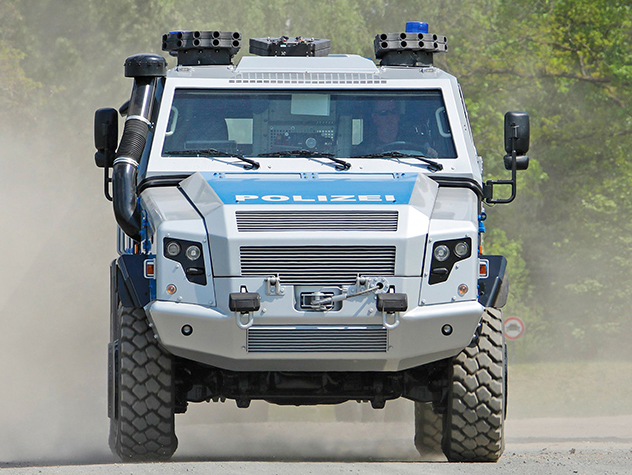
The first PMV generation was developed in 2007–8 by armoured vehicle specialist Achleitner Fahrzeugbau in answer to a solicitation by the Austrian Bundesheer for 145 multipurpose light tactical vehicles of comparable spec to the US Army M-ATV (MRAP – Mine-Resistant Ambush Protected – All Terrain Vehicle). It was an all-Austrian development, built at Wörgl on chassis supplied by MAN in Steyr, with a leaf-sprung front axle, air-suspended rear, and a 280 hp engine. The maximum payload of this 14-tonner was 3.8 tonnes.
In 2013, Rheinmetall MAN Military Vehicles of Germany signed a strategic cooperation agreement with Achleitner to jointly finance the development of an evolution based on the heavier 18.330 TGM chassis, allowing for higher protection and payload capacities. The Survivor R was born.
While the vehicle has so far been built entirely by Achleitner, final assembly of 55 units ordered in January by Germany’s federal ministry of the interior (BMI) to replace the aging (~35-year-old) Unimog-based Sonderwagen 4 will take place at the Rheinmetall Landsysteme plant in Kassel.
(Under the agreement with Rheinmetall, Achleitner continues to market its own versions of the PMV under the Survivor II brand name in a continuum of GVW ratings from 13 tonnes up to 18 tonnes, that being the all-up weight limit for the current TGM chassis generation with single-tyre wheel-ends all round. Except for the 13-tonne variant, all ride on leaf springs front and rear.)
There is no standard »Survivor« — each vehicle is tailor-made for its intended mission. Whereas Generation 1 had shorter wheelbases (3,250–3,650 mm), the Survivor R has a uniform 3,700 mm. None of these corresponds to standard TGM 4×4 dimensions; the wheelbase and length of the chassis are actually modified according to the overall requirements of the vehicle. “Our business is to design, develop, and produce bespoke vehicles. We are able to modify all of our vehicles into many different versions for different categories!” an Achleitner executive told Motorindia in early 2020.
The first “Polizeipanzer“ edition that broke cover in 2016 was reported to have a GVW of 15 tonnes, whereas the demo unit that “PS Profi“ and wildly popular YouTuber Jean-Pierre Krämer tested that year was registered at 16 tonnes. The two vehicles delivered to the German federal state of Saxony the following year were homologated at 17 tonnes, and the Survivor R’s for SEK North Rhine-Westphalia and Berlin a further year on at 17½ tonnes.
The MAN TGM-Mil 4×4 chassis comes in 13- and 18 tonne models, so why specify a 17 or 17½ tonne GVW? As an automaker in its own right, Achleitner is allowed to register the vehicle with a different GVW [from that of the base chassis], the executive above explained. And because the Survivor R is custom-built, “what GVW will be specified is decided case by case, based on the customer’s requirements, equipment, and mission and driving profiles.”
The crew capsule, which sits on elastic mounts atop the chassis, is a monocoque safety cell of 8mm-thick (minimum) armour steel with very high (VPAM 6) basic ballistic protection. Multi-hit protection against more lethal projectiles, including shaped charges and blast fragments from IEDs, is available in the form of modular overlays (a bolt-on armour kit for the exterior consisting of ceramic composite or equivalent) and a spall liner made of woven Dyneema or Kevlar fabric.
Not only does add-on armour entail considerable expense; the sheer weight of the hull imposes a payload penalty for every kilo of additional body weight — so fine-tuning the design for an individual customer requires a level of technical finesse far beyond what you might expect of a conventional vehicle manufacturer.
“We need to take account of the empty weight of the base vehicle (armoured to VPAM 6/7), the customer’s payload requirement, and the permissible gross weight. The difference between the GVW and [the sum of the] kerb weight and payload is the potential weight of the up-armouring,” the exec elaborated.
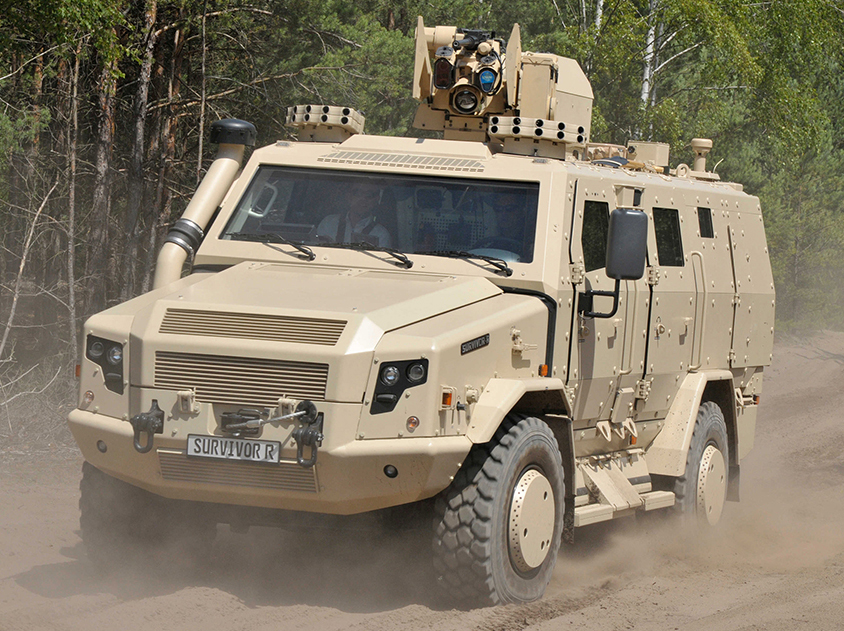
The Survivor R dispenses with the V-shaped hull of conventional MRAP designs; instead, in the interests of higher ground clearance and a lower centre of gravity, the vehicle may optionally be fitted with a shallow multilayer blast shield. In addition to protecting the driveline and underbody from conventional mine threats, this intelligent lightweight design with an inner ceramic composite armour sheath shaped to conform to the floorpan, has also proved resistant (on other vehicles) to penetration by the EFP (explosively formed projectile) variety that’s been the trademark of Shīʿite militias in Iraq.
Hard-nosed hombre
Because of the need to armour the engine cowl, the designers hinged it to the front of the chassis. The set-back hull, which incorporates a 200 litre diesel tank (enough for up to 800 km of operational autonomy), situates the driver and commander aft of the front axle — an approach that guarantees the crew highest-in-class protection against IEDs and mines (up to NATO STANAG Level 2 — 10 kg activated under any wheel or under the vehicle).
The kerb weight of a Survivor R – in baseline configuration with overall height of 2,700 mm – is 12½ tonnes, which leaves a maximum of 5½ tonnes for equipment, add-on protection, a raised roof, etc. A 30 tonne GCW rating for the underlying MAN chassis, its 340 hp Euro 6e engine delivering up to 1,250 Nm of torque to all four wheels through a ZF automated 12-speed or Allison 3000 SP fully automatic transmission, two-speed transfer case, and planetary-reduction hubs, means there’s enough grunt to break through blockades and bulldoze heavy barricades with ease, a boon in riot control situations.
There’s heaps of traction from the lugged 365/85R20 tyres with runflat inserts. Integrated beadlocks ensure the tyre beads stay clamped to the rim at lowered or even total loss of pressure. The reinforced rubber inserts complement the superior impact resistance and energy absorption characteristics of forged aluminium tactical wheels relative to standard steel wheels. The combination has been proven to dramatically lower the blast acceleration from landmine explosions, protecting the integrity of the suspension and enhancing survivability for the vehicle and its crew of up to 12 people.
The controls are the TGM’s — no special training is needed for the driver to get up to speed. Optional electronic transfer case and differential management automatically selects the ideal driving mode in every operating condition for top traction and unbeatable mobility.
The vehicle is designed to ford streams 1.2 metres deep, negotiate a 31° incline, and traverse a 19° side slope. As much as 400 mm of ground clearance under the differentials, and 35°/25°/35° angles of approach/breakover/departure, give this veritable mountain goat on wheels the ability to climb v-steps 400 mm high and cross trenches 850 mm across.
With a top whack in excess of (but electronically limited to) 100 km/h, the Survivor R – as its name indicates – will not only speed SWAT teams and counterterror commandos securely into the thick of danger, but also bring them out alive and kicking. Besides, crucially, also serving as a means to medevac hostages and injured victims from the scene, even under attack from perpetrators.
MAN’s BrakeMatic software blends the action of the EVBec engine valve brake, effective at all four wheels thanks to permanently engaged AWD, with that of the electropneumatic service brake to bring those 18 tonnes safely from top speed to full stop. Hill start assist is standard, and should the crew need to really dig its heels in, there’s also a pneumatic-locking parking brake on the front axle in addition to the spring-actuated one on the rear — a “4×4 brake”, the executive calls it. “It’s a more secure brake when you’re on uneven terrain off road.”
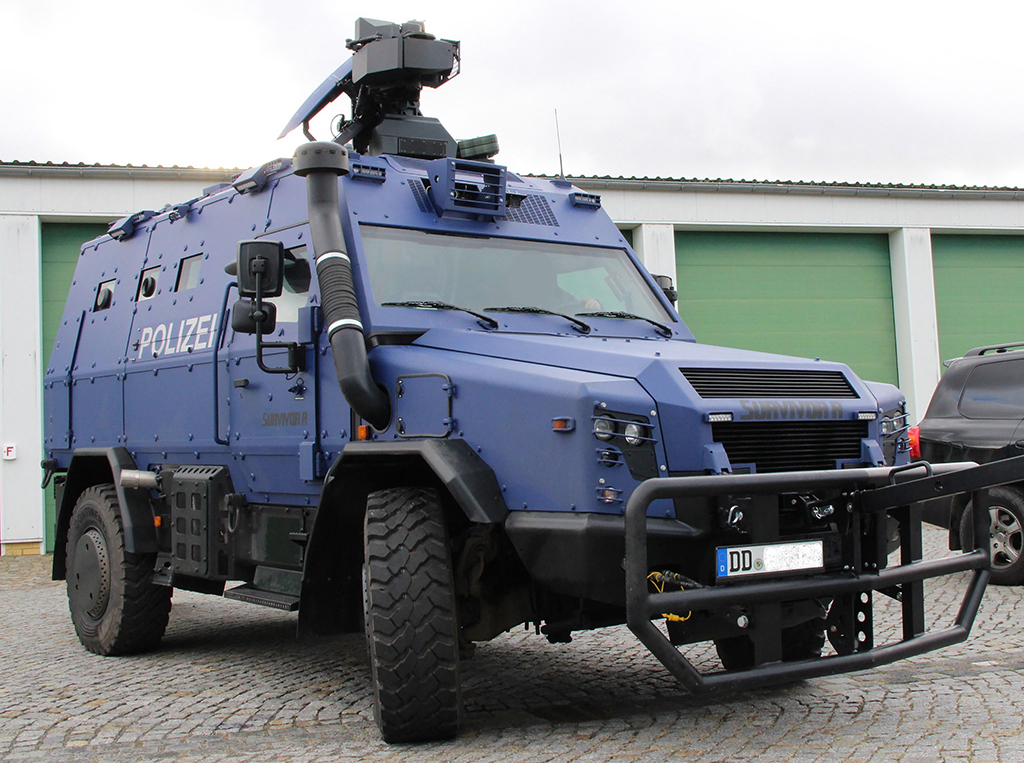
Call the police!
Over the last 7½ years, the Austro-German alliance has systematically developed its MAN of steel into what you might consider the Swiss Army Knife of armoured wheeled vehicles.
First revealed to the public at Eurosatory 2014 in Paris as a showcase for Rheinmetall’s CBRN reconnaissance expertise, the Survivor R made a splash as a roving laboratory bristling with radiation sensors, automated soil and water sampling systems, and powerful spectroscopic and standoff detectors for sample analysis and remote identification of airborne chemical warfare agents and biohazards.
At the IDEX defence exhibition in Abu Dhabi the following February it was shown as a four-person command post complete with battle management system and a roof-mounted Kongsberg Protector Nordic remote weapon station with banks of Rheinmetall ROSY rapid-obscurant grenade launchers. A protected field ambulance went on display at DSEI in London that September, and the first SWAT adaptation proved to be the crowd-puller at the mid-2016 GPEC exhibition in Leipzig.
At present, the portfolio also includes a troop carrier and a two-door protected logistics truck with cargo platform and load handling device for shelter transport. The differences between the security (police) and logistic (military) variants owe to the different requirements for the two missions — in general, logistic vehicles have less special mission kit, whereas police vehicles must be equipped with optronics, PA systems, etc.
Till the most recent BMI order, a total of 55 units in “more than 10 different variants” had been delivered, or were pending delivery, to six customers. The first of these were 10 PMV Survivor IIs for the Turkmenistan Border Guard ordered in 2010 and delivered in 2011, and five more, presumably of Gen. 2, ordered subsequently. The next order, of a media-reported 16 units of the “Polizeipanzer“ adaptation for Austria’s elite EKO (Einsatzkommando) Cobra police tactical unit, came in mid-2016, the first vehicle being delivered that November.
The first German order, indeed the breakthrough order for the Survivor R, was placed by the Free State of Saxony in March 2017. Two very highly specified vehicles were delivered that December, one for the state’s Spezialeinsatzkommando (SEK) antiterror police unit and one for the riot police, at a reported price of €1.5 million apiece. The Berlin Police Department received its “Chuck Norris” the following November, and the SEK of North Rhine-Westphalia acquired its own €1.3 million Sonderwagen the next month.
In mid-2019 the Survivor R business, together with the rest of RMMV’s tactical vehicles, was hived off into Rheinmetall Landsysteme (RLS), a 100 percent Rheinmetall-owned company.
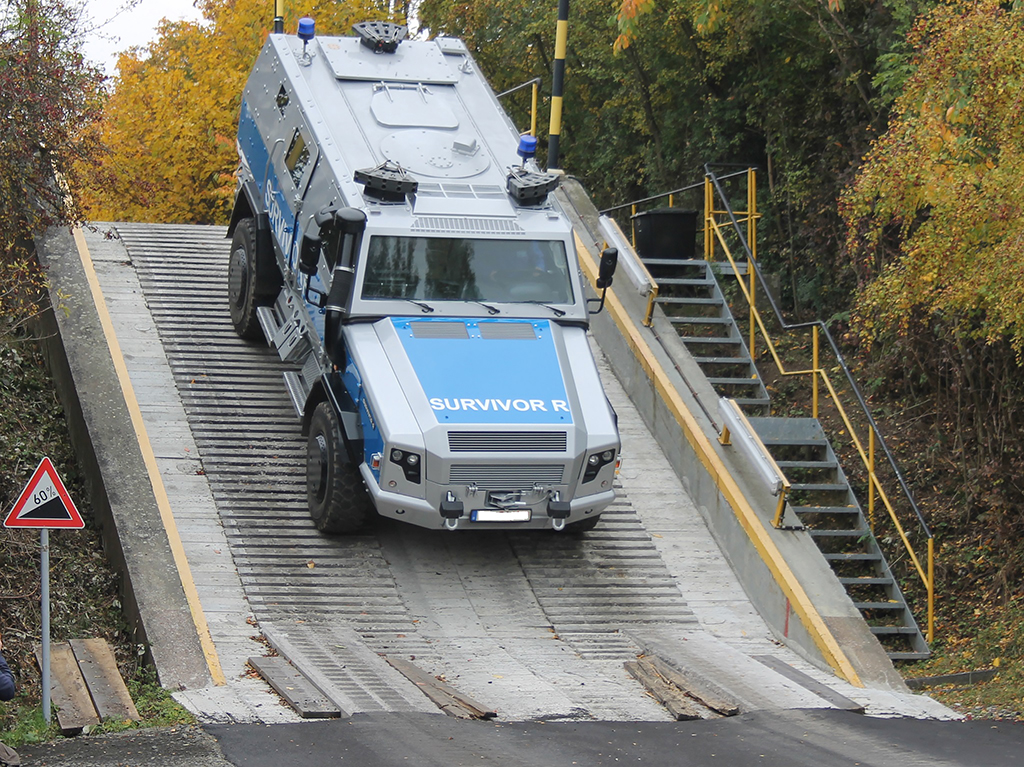
The present order includes an option for, it would appear, 15 more vehicles (at least), although RLS reportedly estimates a minimum demand for 200 law-enforcement vehicles of the category of the Survivor R as police departments all across Germany look to replace their outdated Sonderwagen 4 with a vehicle purpose-designed to combat urban tactical threats that didn’t exist for much of the lifetime of the previous model.
Two variants are envisaged — one for the state police forces (45 units) and another for the Bundespolizei (German federal police, 10 units). In a first step, one sample vehicle of each specification will be delivered later this year for trials, including full certification of their protection features. In the next step, production vehicles are expected to be delivered over a span of three years starting in 2023.
The names of the other tenderers weren’t immediately available, but while direct competitors in the same weight class – the KMW Dingo (Unimog) and Iveco MPV (Trakker) – are also based off of commercial truck chassis, only the TGM-Mil 4×4 that underpins the Survivor R can boast as numerous NATO and non-NATO deployments across geographies. The use of large-series automotive components from MAN’s Steyr-built midrange truck series guarantees the legendary reliability and ease of field repair that MAN trucks are renowned for, plus the assurance of service support across the length and breadth of Germany via the company’s extensive network — an important consideration in any local-government purchase decision.
As for specifications, the Survivor R ticks all the boxes. The police edition can be up-armoured with spaced “swappable” panels of ultra-high-strength sintered nanograin nitrogen steel — lightweight and cost-efficient, but no less effective than ceramic composite armour.
The windscreen and side windows are 10cm-thick slabs of transparent laminated ceramic armour designed to be unscrewed and replaced, and can be specified with shooting ports. The hi-tech ceramic material from the Rheinmetall portfolio weighs half of what conventional bulletproof glass does, but still meets the stringent protection requirements of STANAG 4569 Level 4 and retains its excellent transparency even after multiple ballistic hits.
The cabin is airtight and pressurised to seal the occupants against nuclear, biological, and chemical (NBC) contaminants. The hi-tech modular ventilation and NBC filtration system with combined air-conditioning unit – a “strongly recommended option that most of our customers choose”, a Rheinmetall spokesman says – comes from Beth-El Zikhron Yaaqov Industries Ltd in Israel. The compact modular filter unit consists of a heavy-duty cyclone filter for dust extraction, followed by an additional pre-filter and a series of NBC filter cartridges.
The list of specifiable options includes tyre shields, a fire suppression system for the engine compartment, underbelly, wheel houses, and cabin; high-power window washers; a 10-tonne hydraulic self-recovery winch; a MARS adjustable ramp system; and a variety of optronics and effectors.
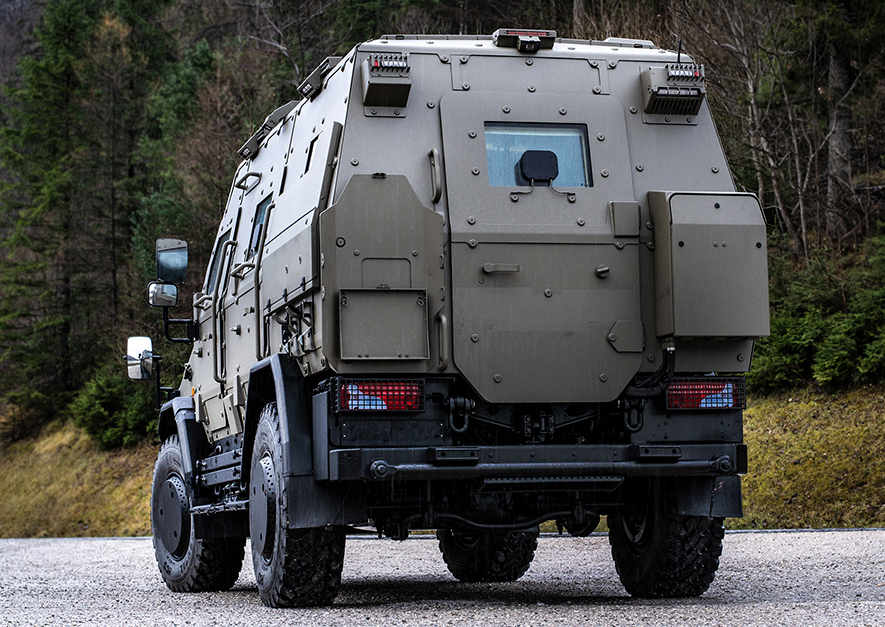
The two Survivors for Sachsen are probably the biggest and baddest that Rheinmetall has delivered to date. The cobalt blue beasts with bull bars are 30 cm longer and almost 30 cm taller than the baseline, for a 1.6m internal height, and are kitted out with mine-safe blast seats isolated from the hull, suspended from the roof by means of rubber springs. In place of the side-hinged rear door, as on the vehicles for the EKO Cobra, is a lowering hydraulic ramp to ease egress for 10 commandos with arms at the ready.
A roof-mounted remote weapon station, digitally controlled from inside the cabin, was initially configured with a searchlight, a high-performance video system with day and night cameras and infrared thermal imaging, and a ROSY module, but additionally equipped with an ammunition case and feeder-belt carrier for a large-calibre gun in anticipation of a change in the law to allow the use of nonlethal rubber bullets.
The Berlin PD’s heavy-metal martial artist may project a considerably less intimidating persona, but it’s no less kick-ass than the Sachsen pair are. As organised crime – and organised chaos – threaten to take over the streets in a growing number of cities across western Europe in the very VUCA 2020s, enforcing the law and keeping the peace is going to take a MAN of blood and iron. There’s no telling how many Survivors we’ll see.